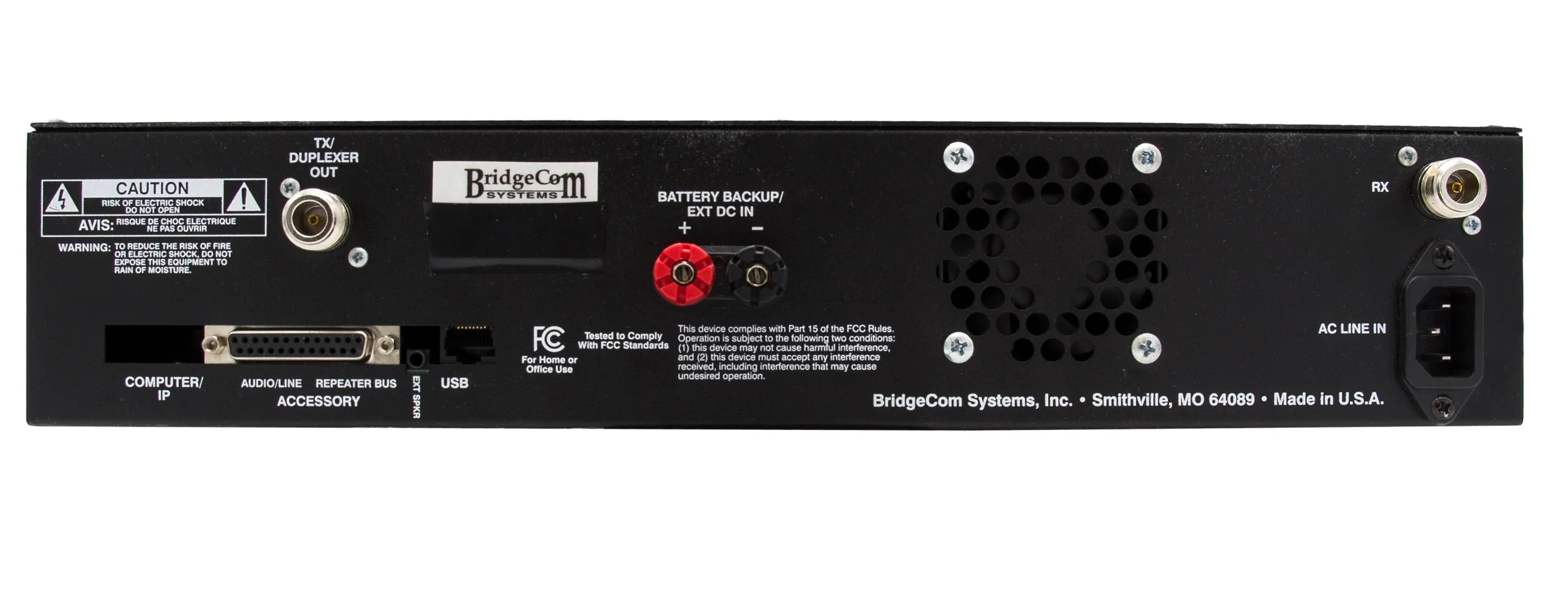
(click on either photo to open a new window at the Bridgecom Systems web site)

(BCR-Series Repeaters and Accessories)
Maintained by Mike Morris WA6ILQ
| Back to Home |
Technical Information on BridgeCom Systems Repeater Products (click on either photo to open a new window at the Bridgecom Systems web site)  (BCR-Series Repeaters and Accessories) Maintained by Mike Morris WA6ILQ |
CONTRIBUTIONS TO THIS PAGE ARE WELCOME!
Actually to any page at this web site!
Page Maintainer's note: My total experience with Bridgecom has been a short conversation with the owner at the Dayton Hamvention in 2023 and this: On one of my site visits there was a new repeater in a tenant rack. It was a UHF Bridgecom labeled with a local amateur radio club name, a personal name and phone number, the UHF frequency and tone. It was there in Febuary of 2023 and on my next visit to that site about six months later it had been replaced with a Motorola MTR2000. Then there was an email I received asking about interfacing a Bridgecom to one port on an RLC controller. I did some research and suggested that the Bridgecom transmitter audio input might be a little too sensitive and a series resistor between 3.3 K and 6.8 K might resolve his issue. He wrote back saying that a series 4.7 K had worked perfectly. That has been my total experience with Bridgecom repeaters... I've never had the opportunity to touch one.
BridgeCom Systems is a USA-based comany that manufactures rack-mount repeaters for the amateur VHF, 220 and UHF bands and they are also sold to VHF and UHF commercial and GMRS customers. The BCR-Series repeaters are available as 50 Watt (136-174 MHz) VHF and 40 Watt (UHF) in two frequency ranges: 400-470 MHz and 450-512 MHz. Internally the BCR-Series repeaters are two TecNet International Inc. / Maxon TM-8402A commercial (LMR) mobile radios that are made in South Korea. The BCR-220 is an amateur only repeater, 30 watts output, and is firmware-limited to 222.0-224.995 MHz. Bridgecom BCR series repeaters are available from several distributors including Amazon. The owner is Ron Kochanowicz KCØQVT.
Articles and Information:
|
|
Building your own Bridgecom BCR-series Repeater Programming Cable By Jared Smudde KD9KOO |
|
|
The BCR programming software can be found "out there" for free download. |
|
|
Bridgecom BCR Owners manual v1.7 |
|
|
Bridgecom BCR-40U / 50V Spec Sheet |
|
|
Bridgecom BCR-220 Specifications Sheet |
|
|
Bridgecom BCR to External repeater Controller conections While this article was written for an Scom 7330 controllers it is also applicable (with connector pin number changes) to Scom 5K, 6K, 7K, Arcom and LinkComm / RLC controllers. |
|
|
Bridgecom BCR-series Repeater Review (offsite link) |
|
|
According to Ron at Bridgecom the power supply module inside the BCR repeaters is a Meanwell LPP-150-13.5 |
|
|
The BCR Series are analog (wideband or narrowband). The BDR Series are DMR and are programmed VERY differently. |
|
|
There is no information in the Version 1.7 manual above on Part 22, 74, 90 or 95 (GMRS) compliance. You will notice on the rear photograph above that there is no FCC ID number. From the web page at https://groups.io/g/repeater-builder/topic/warning_for_users_of/84358579 where Joe - WA7JAW says: ... I first tried contacting Bridgecom to get the FCC ID numbers for Part 90. I never got a response back from them. I then contacted the FCC. Office of Engineering and Technology (OET). They were unable to find any BCR-xxx repeaters in their system at that time. This was back in 2019. What I found was that Bridgecom was using the FCC ID numbers of the mobiles for their claims. I was told by the FCC engineer that since the radios were not in the same configuration as when they were tested, they were no longer covered by the certification. |
That's all we have at this time. Anyone want to write a review or a more detailed interfacing article?
Back to the top of the page
Back to Home
This page created on Saturday 08-Feb-2025.
Last edited on 11-Feb-2025
Article text, artistic layout, and hand-coded HTML © Copyright 2025.
This web page, this web site, the information presented in and on its pages and in these modifications and conversions is © Copyrighted 1995 and (date of last update) by Kevin Custer W3KKC and multiple originating authors. All Rights Reserved, including that of paper and web publication elsewhere.